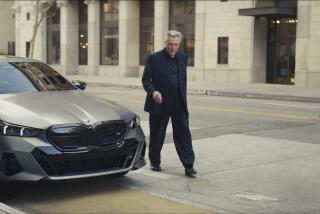Commercial Extravaganzas Worth Cost, Say Firms
- Share via
NEW YORK — When Apple Computer spent $600,000 to make a vision called “Lemmings,” a 60-second commercial depicting an army of blindfolded businessmen marching off a cliff, some critics called it over-priced creative vanity.
The commercial, which aired during the Superbowl, was shown only once. Despite the criticism, the Cupertino, Calif.-based computer company felt “Lemmings” was well worth the production cost, and the additional $1 million spent on air time.
“We knew it was going to be a controversial commercial. It was a bold advertisement. But we had a message to deliver, and we wanted to make sure it was heard,” said Kathleen Dixon, a spokeswoman for Apple.
That damn-the-torpedos attitude is finding more defenders among Madison Avenue moguls.
The objective is to create a TV ad that is not just a commercial, but a film extravaganza. In the parlance of the trade, creators hope these commercials are “unzappable”--so compelling, intriguing or exciting that the viewing public will sit, transfixed, while taking in the sales pitch.
But such aspirations aren’t cheap, and skeptics question whether the production costs of any commercial should reach the proportions of some recent efforts.
Hooper White, a Barrington, Ill.-based advertising consultant, said the cost to an advertiser of a network-quality 30-second commercial ranges between $130,000 and $150,000. That does not include the cost of buying air time which can run as high as $500,000 for 30 seconds.
“Leading edge commercials are experimental, so it’s hard to estimate cost,” said White, pointing out that production of those spots can incur “incredible cost over-runs.”
Neil Tardio, an independent producer who has worked for such clients as American Express, the Army and Chrysler, argues that in the long run, the expense generally is worth it.
Since companies typically will spend millions researching the marketplace and purchasing air time, it makes sense to pay top dollar for an ad that is well executed, he said.
Executive Enraged
Tardio recalls filming an ad for American Express travelers checks in Venice. A vacationing NBC executive asked what movie was being shot. When Tardio replied, amid the extras and the film crews, that it was a commercial for American Express, the executive was enraged at the extravagance.
Tardio, for his part, maintains that commercials crafted with such loving care and healthy budgets often make for better viewing than the programming that runs on television networks.
“Sometimes big ideas require big productions, and big productions require big money,” said Philip Dusenberry, vice-chairman and executive creative director for BBDO International, an advertising agency which makes ads for such companies as General Electric and Pepsi-Cola.
Dusenberry, along with music-video director Bob Giraldi, was responsible for the three-minute Pepsi commercial featuring Lionel Richie on the recent Grammy Awards program, where Richie walked off with two of the prestigious awards.
Pepsi declined to give the production cost for the Richie ad--really three separate commercials strung together for the special airing--but a spokesman for the Purchase, N.Y.-based company said the company paid CBS $1 million to run it.
The paean to Pepsi contained more than 3,000 singing and dancing extras. Pepsi ran newspaper ads announcing the commercial, proclaiming it the “most talked-about commercial of the year.” Dusenberry also worked on the famed Michael Jackson commercials for Pepsi that first ran during the 1984 Grammys. Those ads cost $1.5 million to make.
The Jackson commercials, said Dusenberry, boosted Pepsi to No. 1 in brand awareness, according to Video Storyboards, which regularly polls consumers on commercials they remember best.






